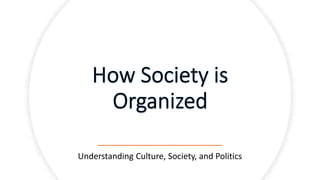
Ucsp.module2.lesson4
- 1. Understanding Culture, Society, and Politics
- 2. “We are lonesome animals. We spend all our life trying to be less lonesome.” - John Steinbeck
- 3. Humans always move and live in groups since the ancient times. Humans bond and survive together
- 4. Question: •What drives us to organize society? a. due to our instinct to survive b. it is our nature to build & destroy cities, civilizations, cultures & then build again
- 5. QUESTION Why is there a need for social group? Do we really depend on it?
- 6. The answer is YES • Everyone wants a sense of belonging • Man is by nature a social being and he interacts with others… (Aristotle) • As members, we think of ourselves as a special “WE”
- 7. • Smaller units that compose a society • It is a unit of interacting personalities with an interdependence of roles and statuses existing between members GROUPS
- 8. Importance of Groups (Salcedo 2002) 1. The group is a transmitter of culture. 2. The group is a means of social control. 3. The group socializes the individual. 4. The group is the source of ideas. 5. The group trains the individual in communications.
- 9. • Is two or more people who identify with and interact with one another (Macionis, 2012). • It is where human beings come together in couples, families, circles of friends, churches, clubs, businesses, neighborhoods and large organizations • Whatever the form, it is made up of people with shared experiences, loyalties and interests • A collection of people who have something in common and who believe that what they have in common is significant. SOCIAL GROUPS
- 10. CHARACTERISTICS OF SOCIAL GROUP 1. Group members interact on a fairly regular basis through communication. 2. Members should develop a structure where each member assumes a specific status and adopts a particular role. 3. Certain orderly procedures and values are agreed upon. 4. The members of the group feel a sense of identity.
- 11. However, NOT EVERY COLLECTION OF INDIVIDUALS FORM A GROUP 1. SOCIAL CATEGORY (people with a status in common ) shared social characteristic, like gender, race, ethnicity, nationality, age, class, etc. e.g. EXAMPLES: women, homeowners, soldiers, skilled workers, professionals, millionaires, college graduates, and Roman Catholics
- 12. However, NOT EVERY COLLECTION OF INDIVIDUALS FORM A GROUP 2. CROWD loosely formed collection of people in one place EXAMPLES: (e.g. students sitting in a large stadium with interaction at a limited extent).
- 14. However, NOT EVERY COLLECTION OF INDIVIDUALS FORMS A GROUP 3. SOCIAL AGGREGATE • a collection of people who are in the same place at the same time, but who otherwise do not necessarily have anything in common, and who may not interact with each other. EXAMPLES: •When we walk down a crowded sidewalk, eat in restaurant, •Ride public transit with other passengers, and shop in stores
- 15. 1. Motivational base shared by individual 2. Size of group 3. Type of group goals 4. Kind of group structure
- 16. Who leads the group? A LEADER: someone who influences other people in the group. 1.Instrumental leader: focused on a group’s goal, giving orders and making plans in order to achieve those goals. 2.Expressive leader: looking to increase harmony and minimize conflict within the group.
- 17. Leadership Styles 1. Authoritarian leaders: lead by giving orders and setting down rules which they expect the group to follow. 2. Democratic leaders: lead by trying to reach a consensus instead of issuing orders. They consider all viewpoints to try and reach a decision. 3. Laissez-faire leaders: they are extremely permissive, and mostly leave the group to function on its own.
- 20. Small, intimate and less specialized group, bound by a very strong sense of belonging. It is joined by primary relationships where people: spend a great deal of time together engage in a wide range of activities they feel that they know one another pretty well.
- 21. A large and impersonal social group whose members pursue a specific goal or activity. Examples: Industrial Workers; business associates, Faculty Staff, Company Employees Involve weak emotional ties and little personal knowledge of one another.
- 22. It exist for only a short time, beginning and ending without particular significance Other Examples: Students enrolled in the same course at a university who may not see one another after the semester ends Involve weak emotional ties and little personal knowledge of one another.
- 25. A member can identify him/herself within that group & which individuals feel at home.
- 26. ethnicity, race, faith and ideology. common interests, pastime or hobbies like playing chess, cooking, backpacking, gardening etc. very specific: being students of one school, citizens of a country, employees of a company etc.
- 27. A social unit to which individuals do not belong due to differences in social categories and with which they do not identify.
- 28. The Lasallians and Ateneans. I play chess intensely that I do not hang-out with basketball players.
- 29. The group is used to determine the reference point in so far as the kind of expected behavior or norm one should act or manifest.
- 30. A person can have multiple reference groups. It can be used as basis for what someone aspires to be- role model. Has great influence in the way we create our own identities, the groups we form & aspire us to be what we want.
- 31. a series or web of social ties involving people or groups of individuals connected to each other. EXAMPLES: Connected through friendship, family, business relationship, academic institutions, religious organizations.